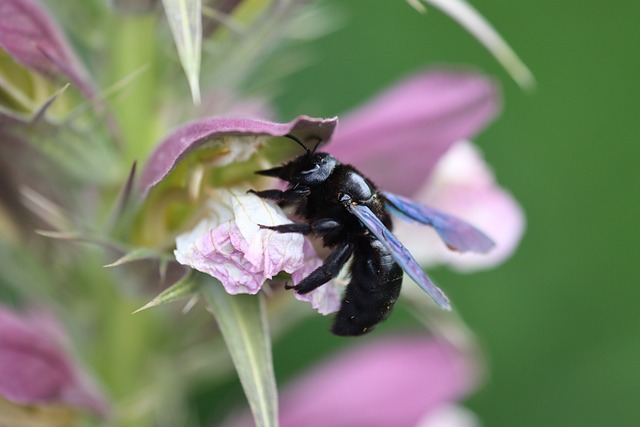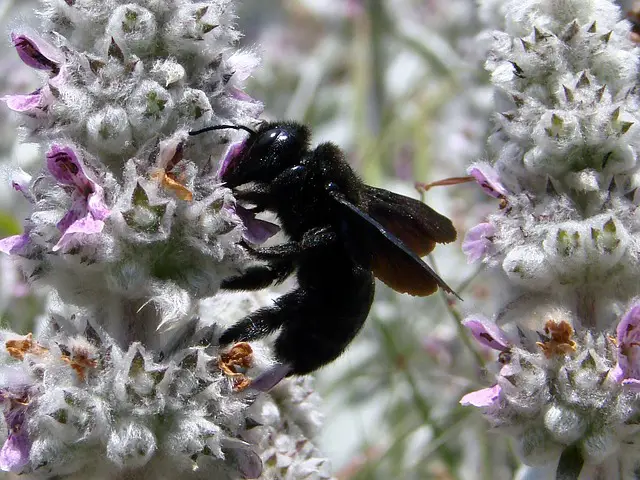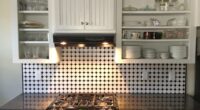Carpenter bees are solitary insects that burrow into wood to create nests, Honey bees live in large colonies and build intricate hives.
TL;DR Carpenter bees Vs. Honey bees
Carpenter bees are solitary and bore holes in wood for nesting, while honey bees live in large colonies with complex social structures and build wax honeycombs.
Carpenter bees have a less hairy and shiny appearance, while honey bees are more hairy with yellow-brown bodies and black stripes. Both play vital roles in pollination but have distinct behaviors and nesting habits.
What are carpenter bees?

Carpenter bees are a type of solitary bee that can be found in various parts of the world, including North America. Carpenter bees prefer to make their nests alone. These industrious insects get their name from their unique ability to create tunnels or galleries within wooden structures.
What are honey bees?

Honey bees, scientifically known as Apis mellifera. They are social creatures and live in large colonies consisting of thousands of individuals.
These industrious insects are famous for their ability to produce honey through the collection and processing of nectar from flowers. Honey production is not just for their own sustenance but also serves as a valuable food source for other animals and humans alike.
Carpenter bees Vs. Honey bees – Key differences
| Aspect | Carpenter Bees | Honey Bees |
|---|---|---|
| Family | Xylocopidae (Subfamily: Xylocopinae) | Apidae (Subfamily: Apinae) |
| Nesting Behavior | Bore tunnels in wood for nesting | Build intricate wax honeycombs |
| Sting | Males do not have stingers | Females have stingers for defense |
| Social Structure | Mostly solitary (some may be communal) | Highly social, live in colonies |
| Honey Production | Do not produce honey | Store honey for colony sustenance |
| Pollination | Efficient but not primary pollinators | Crucial pollinators for ecosystems |
| Size | Generally larger in size | Generally smaller in size |
| Body Hair | Less hairy body | More hairy body |
| Color | Usually black with some yellow markings | Yellow-brown with black stripes |
| Diet | Feed on nectar and pollen | Feed on nectar and pollen |
| Aggressiveness | Females may sting if provoked | May sting to defend the colony |
| Nesting Sites | Bore holes in wood, eaves, and decks | Construct hives in various locations |
Carpenter bees Vs. Honey bees – Appearance
Carpenter Bees
- Larger in size compared to honey bees.
- Less hairy body with a shiny and smooth appearance.
- Typically black in color, with some species having yellow markings on the head and thorax.
Honey Bees
- Smaller in size compared to carpenter bees.
- More hairy body, with dense hair covering their body.
- Yellow-brown with black stripes on the abdomen, giving them a characteristic appearance.
Carpenter bees Vs. Honey bees – Character traits
Carpenter Bees
- Nesting Behavior: Carpenter bees are solitary bees or have limited communal nesting habits. Females bore tunnels in wood, such as eaves, decks, or other wooden structures, to create individual nests for laying eggs. They do not form large colonies like honey bees.
- Aggressiveness: Male carpenter bees, though they may appear aggressive, do not have stingers and cannot sting. However, they may buzz around and appear intimidating when protecting their territory. Females, while having stingers, are less aggressive and will usually only sting if directly provoked or threatened.
- Honey Production: Carpenter bees do not produce honey. Instead, they collect nectar and pollen for their own consumption and the nourishment of their offspring.
Honey Bees
- Nesting Behavior: Honey bees are highly social insects that live in large colonies. They construct intricate wax honeycombs in hives or other sheltered locations, with a well-defined social structure, including a queen, worker bees, and drones.
- Aggressiveness: Honey bees can be defensive of their colony. When threatened, worker honey bees may sting to protect the hive and the queen. Unlike male carpenter bees, male honey bees (drones) have stingers, but they are not used for defense since they lack the ability to sting effectively.
- Honey Production: Honey bees are well-known for their honey production. They collect nectar from flowers and process it into honey, which serves as a crucial food source for the colony, particularly during periods of scarcity or winter.
Honey bees’ highly organized social structure and honey production have made them more widely recognized and economically significant in agriculture and food production.
Carpenter bees play a role in pollination but are less recognized due to their solitary nature and limited nesting behaviors.
Carpenter bees Vs. Honey bees -Pollination
Carpenter Bees
- Pollination Efficiency: Carpenter bees are generally efficient pollinators because of their ability to buzz-pollinate. Buzz-pollination is a technique where the bee grabs onto a flower and rapidly vibrates its flight muscles, dislodging pollen from the flower’s anthers. This can be especially effective for certain types of flowers that require vibration to release their pollen.
- Flower Preferences: Carpenter bees tend to prefer flowers with larger and open faces where they can easily access the nectar and pollen. They are particularly attracted to tubular-shaped flowers.
Honey Bees
- Pollination Efficiency: Honey bees are extremely efficient and effective pollinators. As highly social insects living in large colonies, they can cover extensive areas foraging for nectar and pollen.
- Flower Preferences: Honey bees are generalist pollinators and visit a wide variety of flowers, including both open-faced and more complex flowers. They have evolved to forage on a diverse range of plant species.
- Behavior: Honey bees perform a “waggle dance” to communicate the location of rich nectar and pollen sources to other members of the hive. This communication helps the colony efficiently exploit food sources.
Why are carpenter bees important?
- Pollination: They play a role in pollinating various plants, aiding in their reproduction and supporting biodiversity.
- Biodiversity: By pollinating diverse plants, they help sustain ecosystems and support a wide range of animal species.
- Food Source: They serve as a food source for predators and parasitoids, contributing to the food web.
- Ecological Balance: Carpenter bees help regulate plant growth and control herbivorous insect populations.
- Soil Aeration: Their tunneling behavior helps aerate the soil, benefiting soil health.
- Evolutionary Relationships: They have mutualistic relationships with certain plant species, supporting co-evolution and species survival.
- Conservation: Preserving carpenter bee populations contributes to ecosystem health and sustainability.
How can you tell if you have a carpenter bee problem?
Bee Sightings: If you frequently see large bees with shiny, black abdomens hovering around wooden structures on your property, there’s a possibility of carpenter bees nesting.
Boring Holes: Look for perfectly round, half-inch diameter holes in wooden surfaces. These holes are the entry points to carpenter bee nests. You may also notice fresh sawdust or wood shavings near the holes.
Buzzing Sounds: Male carpenter bees can be territorial and may hover around nests, emitting a buzzing sound as they defend their territory.
Wood Damage: Over time, carpenter bees can cause structural damage to wood by tunneling and nesting inside it. If left unchecked, this can weaken wooden structures.
Stains or Discoloration: Carpenter bee activity may lead to stains or discoloration around the entry holes due to the excretion of waste materials.
Increased Activity in Spring: Carpenter bees are most active during the spring and early summer when they establish their nests and lay eggs. Increased bee activity during this time may indicate a problem.
Larval Emergence: During summer or early fall, you may notice young bees emerging from the nesting holes.
If you observe these signs or suspect a carpenter bee infestation, it is essential to address the issue promptly. While carpenter bees are important pollinators, they can cause damage to wooden structures over time.
Consider seeking help from a professional pest control service or carpenter to safely and effectively manage the carpenter bee problem while also considering conservation efforts to protect these valuable pollinators.
Carpenter bee removal
- Identify Infested Areas: Locate the carpenter bee nesting sites by looking for round holes in wooden structures.
- Protective Gear: Wear protective clothing to minimize the risk of bee stings.
- Treatment: Use insecticidal dust to kill the adult bees and larvae inside the tunnels.
- Seal the Holes: Plug the entry holes after a few days to prevent reinfestation.
- Preventive Measures: Paint or stain wooden surfaces and seal potential nesting sites to discourage future bee activity.
- Alternative Nesting Sites: Provide carpenter bee traps or nesting boxes away from wooden structures.
- Professional Help: If needed, seek assistance from a professional pest control service.
Disclaimer:
The information provided for carpenter bee removal is intended for general guidance purposes only. Dealing with carpenter bees and any pest infestation carries inherent risks, including potential bee stings and exposure to insecticides. It is essential to exercise caution and prioritize safety when attempting to remove carpenter bees.
Image Credits
Featured Image By – David Mark from Pixabay
Image 1 By –Roland Steinmann from Pixabay
Image 2 By – Myriams-Fotos from Pixabay








